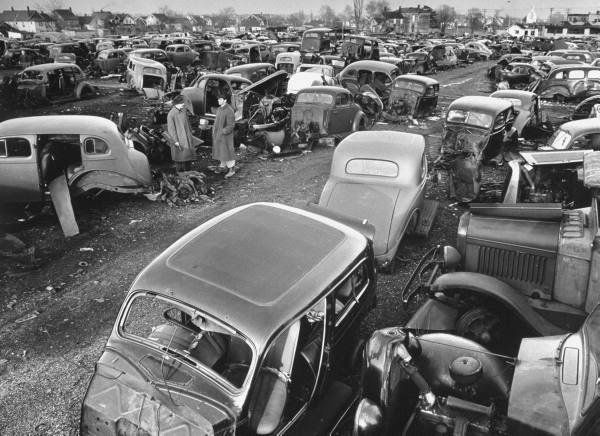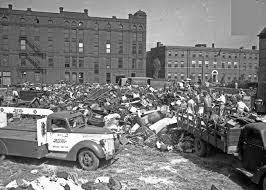The History of Vehicle Recycling
The history of vehicle recycling is a journey that traces back to the early 20th century and has evolved significantly through the decades. Vehicle recycling has played an important role in conserving resources and reducing environmental impact, with the automotive industry and vehicle manufacturers at the forefront of this evolution.
Early Practices in Vehicle Recycling
In the early 20th century, vehicle recycling was rudimentary and mostly driven by necessity. During this period, vehicles were still a novelty, and old vehicles were often kept running for as long as possible. When they were no longer roadworthy, scrap cars were typically sent to junkyards where reusing car parts was common practice. The primary focus was on salvaging car parts like engines, transmissions, and other reusable components, as this was the most cost-effective method of dealing with end of life vehicles.
During World War I, the need for metal recycling increased as metals were in short supply due to the war effort. This period marked the beginning of more organized recycling processes for vehicles, although it was still far from the sophisticated systems we have today.

The Impact of World War II
World War II had a profound impact on the automotive recycling industry. The war effort required vast amounts of materials, leading to the establishment of scrap drives where scrap metal from scrapped vehicles was collected en masse. The shortage of raw materials during the war meant that recycling processes became more critical, and vehicle recycling played a vital role in supplying the necessary metals for manufacturing military equipment.
This period also saw the implementation of various initiatives to maximize the recovery of materials from scrapped vehicles. Vehicle manufacturers and the government worked together to set clear targets for the collection and recycling of end of life vehicles. The practices established during the war laid the groundwork for more structured recycling methods in the post-war era.
Post-War Industrial Growth
The post-war period saw significant economic growth and a boom in the automotive industry. With the increase in vehicle manufacturing, the number of old vehicles reaching the end of their useful life also grew. This led to the development of a more formalized automotive recycling industry.
In the 1950s and 1960s, recyclers began to establish more organized business models to handle the influx of scrap cars. Automotive shredder residue became a key component of the recycling process, where large machines, known as shredders, were used to break down vehicles into smaller, more manageable pieces. This allowed for the separation of non-ferrous metals and other materials for further processing.
During this time, the focus was primarily on recovering valuable metals like steel and aluminum. However, the recycling of other components, such as engine oil and brake fluid, was less developed. The industry was driven by the need to recover maximum value from each vehicle, with an emphasis on recycled parts and materials.
The Environmental Movement and Legislative Changes
The environmental movement of the late 20th century brought significant changes to the vehicle recycling landscape. Growing awareness of the environmental impact of waste and pollution led to the introduction of new regulations aimed at reducing the amount of waste sent to landfill and promoting the recycling of end of life vehicles.
Legislation such as the Clean Air Act and Clean Water Act in the United States set new standards for the handling and disposal of hazardous materials from scrapped vehicles. These laws required proper handling and disposal of hazardous substances like engine oil, brake fluid, and other harmful substances. Vehicle manufacturers were also mandated to design vehicles with recycling in mind, leading to the development of more recyclable components and materials.
In Europe, the End of Life Vehicles Directive (ELV Directive) was introduced to ensure that 85% of the weight of a vehicle could be recycled or reused. This legislation played a critical role in shaping the automotive recycling industry by setting strict targets for the recycling and recovery of materials from end of life vehicles.
Technological Advancements
Technological advancements have revolutionized the vehicle recycling industry in recent years. Innovations in recycling processes and equipment have made it possible to recover more materials and improve the efficiency of recycling operations. The introduction of advanced shredders, automated sorting systems, and sophisticated material separation technologies has enhanced the ability to recycle car parts and recover valuable metals and other materials.
One significant advancement is the use of automotive shredder residue to separate and recover non-ferrous metals and plastics from shredded vehicles. This technology has significantly increased the recovery rates of valuable materials and reduced the amount of waste sent to landfill.
Additionally, the development of e-commerce platforms has facilitated the sale of recycled parts and components, making it easier for consumers and businesses to access reused car parts. This has further integrated vehicle recycling into the circular economy, promoting the reuse of materials and reducing the need for new raw materials.
The Rise of Electric Vehicles
The increasing popularity of electric vehicles (EVs) presents new challenges and opportunities for the automotive recycling industry. EVs contain different materials and components compared to traditional internal combustion engine vehicles, including batteries that require specialized recycling processes.
Recycling electric vehicles involves handling and recovering materials such as lithium, cobalt, and other critical minerals from batteries. This has led to the development of new technologies and methods to safely and efficiently recycle EV batteries, ensuring that valuable materials are recovered and hazardous substances are properly managed.
As the number of EVs on the road continues to grow, the automotive recycling industry will need to adapt to these changes. This includes developing new business models, investing in technological advancements, and working with vehicle manufacturers to design EVs with recycling in mind. The shift towards EVs also highlights the importance of recycling in reducing the environmental impact of vehicles and conserving natural resources.
The Future of Vehicle Recycling
Looking ahead, the future of vehicle recycling is expected to be shaped by ongoing technological advancements, changing regulations, and the increasing adoption of electric vehicles. The industry will continue to play a crucial role in promoting sustainability and reducing the environmental impact of the automotive industry.
Future trends in vehicle recycling include the development of more efficient and effective recycling processes, the integration of digital technologies to track and manage scrapped vehicles, and the expansion of e-commerce platforms for recycled parts. The industry will also likely see greater collaboration between vehicle manufacturers, recyclers, and policymakers to ensure that recycling targets are met and that the transition to a circular economy is achieved.
As the industry evolves, it will be essential to continue investing in research and development to address the challenges posed by new vehicle technologies and materials. This includes finding innovative ways to recycle complex components, such as catalytic converters and EV batteries, and ensuring that the quality control of recycled materials meets the standards required for their reuse.
Overall, the history of vehicle recycling is a testament to the automotive industry’s ability to adapt and innovate in response to changing economic, environmental, and technological conditions. By continuing to build on this legacy, the industry can play a vital role in creating a more sustainable and cost-effective future for all.

